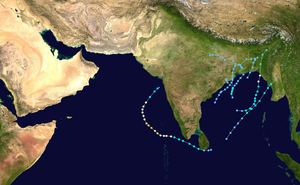Cyclone Maarutha
Cyclone Maarutha was the first tropical cyclone of the 2017 North Indian Ocean cyclone season. It was a relatively short-lived and weak system, but it was the first to make landfall in Myanmar in April. Although a weak system, it caused notable damage in Myanmar. Maarutha formed from an area of low pressure over the southern Bay of Bengal on April 15. The next morning, RSMC New Delhi upgraded the low pressure area to a Depression and designated it as BOB 01.
| Cyclonic storm (IMD scale) | |
|---|---|
| Tropical storm (SSHWS) | |
 Cyclone Maarutha at peak intensity on April 16 | |
| Formed | April 15, 2017 |
| Dissipated | April 17, 2017 |
| Highest winds | 3-minute sustained: 75 km/h (45 mph) 1-minute sustained: 85 km/h (50 mph) |
| Lowest pressure | 996 hPa (mbar); 29.41 inHg |
| Fatalities | 4 direct |
| Damage | $23,400 (2017 USD) |
| Areas affected | Andaman and Nicobar Islands, Yunnan, Myanmar, Sri Lanka |
| Part of the 2017 North Indian Ocean cyclone season | |
Meteorological History

On April 11, an upper air circulation developed over the Andaman Sea, where it moved north-eastwards and concentrated into a low pressure trough over the next day.[1] The United States Joint Typhoon Warning Center (JTWC) started monitoring the system as a tropical disturbance on April 13, while it was some 880 mi (1,415 km) southwest of Yangon.[2] JTWC reported that the disturbance was located within a favourable environment for further development and that convection had started to wrap into the elongated low level circulation centre .[2] The system continued to develop and was classified as Depression BOB 01, by the India Meteorological Department (IMD) early on April 15.[3]
Preparations
Myanmar
The Union Minister for Social Welfare, Relief and Resettlement, the Vice President, ministers and disaster response team of Myanmar had an emergency meeting on the morning of April 16 to prepare rescue teams and arrange food and water stockpiles in disaster zones.
Andaman and Nicobar Islands
Shortly after the development was reported, the cyclone struck, causing severe waves and hence harm for people on the water.[4]
Impact and aftermath
Myanmar

A total of 81 houses, worth about Ks3.7 million were damaged by the storm. Three houses were destroyed by fallen trees. Six lamp posts collapsed.[5] Some houses had superficial damage as coconut palms collapsed on them. The Myanmar Meteorological Agency reported that accumulated rainfall for the 24 hours before April 17 at 9:30 a.m. local time totaled 3.7 inches (96 mm) for Bago. The town of Pyay received 5.4 inches (139 mm). In the Rahkine Region, the city of Kyauckpyu received 4.6 inches (119 mm) of rainfall in a 24-hour period. In the Mon State, Thaton, a town in southern Myanmar received 4.3 inches (111 mm) of rainfall.[6] Four people were reported killed in the Irrawady division of Myanmar.[7]
India
Cyclone Maarutha, as a deep depression, left hundreds of tourists stranded in Havelock Island of Andaman and Nicobar Islands from heavy rainfall.[8]
In Andhra Pradesh and Odisha, heatwave conditions worsened as the cyclone drew all the moisture towards itself resulting in severe hot and dry weather.[9]
Records
Myanmar shares the Bay of Bengal coast with neighbouring countries Bangladesh and India.[10] It has experienced strong tropical cyclones from May to November. Notable destructive cyclones that affected Myanmar include Cyclone Nargis in 2008, Cyclone Giri in 2010 and Cyclone Mala in 2006.[11] According to the IMD, Maarutha was the first ever cyclone to maintain peak intensity until landfall on Myanmar in the month of April. Cyclone Bijli in April 2009 weakened into a depression prior to landfall in Bangladesh.[12]
See also
- Cyclone Bijli – a storm of similar intensity in 2009 that made landfall in Bangladesh
- Cyclone Mora – a strong tropical cyclone in 2017 which made landfall near Maarutha's landfall.
References
- Cyclonic Storm "Maarutha" over the Bay of Bengal (PDF) (Report). India Meteorological Department. May 22, 2017. Retrieved October 22, 2017.
- Significant Tropical Weather Advisory for the Indian Ocean April 13, 2017 18z (Report). United States Joint Typhoon Warning Center. April 13, 2017. Archived from the original on May 15, 2018. Retrieved October 22, 2017.
- "Tropical Weather Outlook for North Indian Ocean issued at 0300 UTC of April 15 2017" (PDF). India Meteorological Department. Archived from the original on April 15, 2017. Retrieved April 15, 2017.CS1 maint: BOT: original-url status unknown (link)
- "Cyclonic Storm,'Maarutha' causes heavy rain in Andamans". April 19, 2017.
- "Three Die in Cyclone Maarutha". Reliefweb. April 18, 2017. Archived from the original on April 20, 2017. Retrieved May 25, 2018.
- "Maarutha makes landfall, weakens". The Global New Light of Myanmar. April 18, 2017.
- "4 killed as Cyclone Maarutha hits Irrawaddy Delta". May 31, 2017. Archived from the original on June 2, 2017. Retrieved June 1, 2017.
- "Cyclone Maarutha brings heavy rain in Andamans". May 31, 2017. Retrieved June 1, 2017.
- "Cyclonic Storm,'Maarutha' rises temperatures in Odisha and Andhra Pradesh". April 19, 2017.
- "Cyclonic Storm,'Maarutha' over the Bay of Bengal (15-17April 2017): A Report" (PDF). April 19, 2017.
- "Cyclonic Storm,'Maarutha' over the Bay of Bengal (15-17April 2017): A Report" (PDF). April 19, 2017.
- "Cyclonic Storm,'Maarutha' over the Bay of Bengal (15-17April 2017): A Report" (PDF). April 19, 2017.
External links
| Wikimedia Commons has media related to Cyclone Maarutha. |
- 01B.MAARUTHA from the U.S. Naval Research Laboratory
